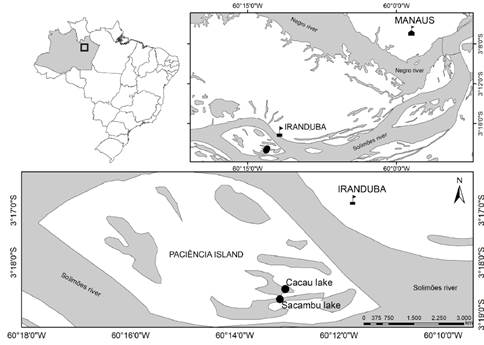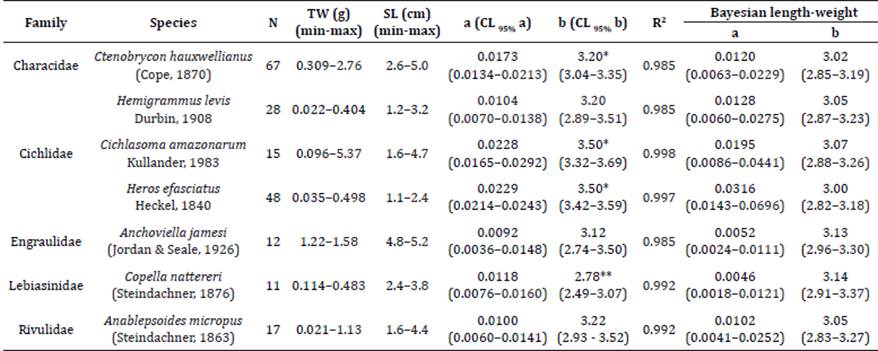INTRODUCTION
The Amazon is the source of many species of ornamental fish, extracted from nature, found in the world aquarium market 1. In addition, has the most diversified ichthyofauna in the world 2 which comprises small-sized species living in lakes, floodplain and small streams 3.
Because of this diversity, studies about length-weight relationships (LWR) of ornamental fish have been more frequent, highlighting the studies by Santos et al 4, Gaspar et al 5, Barros et al 6, Freitas et al 7 and Salvador et al 8. Nevertheless, still there is a lack of information and few studies were conducted in the Solimões River basin about the LWR of ornamental fish species from floodplain lakes.
The studies of LWR have a wide application, despite being easily obtained many data were not published for several species. These data become very relevant, especially in the Amazon, where fishes represent a relevant economic source, either commercial or ornamental 9.
The LWR are important in management and conservation because they are helpful for the evaluation of fish populations when only length measurements exist and enable the computation of condition indexes and the comparison of species growth (between sexes, seasons or regions) 10. In addition, relationships of total, standard and fork lengths of fishes are also important for comparative growth studies 11.
Given the information presented, the objective of the research was to determine the LWR of the ornamental fish from floodplain lakes in the Solimões River.
MATERIALS AND METHODS
The Paciência island is a fluvial island located in the rural area of the city of Iranduba, in lower Solimões River, far away about 45 km from the confluence with the Negro River, Amazonas, Brazil (Figure 1).
The samples were obtained in two lakes: Sacambú and Cacau. The fish were caught in mixed floating meadows during the flood in June 2017 and dry in January 2018, once in each season, using purse seine (7 m × 4 m, mesh size = 3 mm). The definition of the hydrological cycle seasons followed Bittencourt and Amadio 12.
The specimens captured were anesthetized using eugenol (15 mg · L-1), fixed (formalin 10%) and stored (ethanol 70%) after 10 days. The Biometry (Standard Length and Total Weight) was realized at the Fishery Ecology Laboratory of the Federal University of Amazonas, using precision balance (0.001 g) and ichthyometer (0.1 cm).
The values were determined by non-linear estimation using the algorithm of Levenberg-Marquardt, a technique widely adopted in a broad spectrum of disciplines and that provides solution to problem called Nonlinear Least Squares Minimization 13, in the equation: TW= a × SL b (14, TW (total weight), SL (standard length), a (intercept) and b (allometric coefficient). Plots of TW and SL were used to exclude outliers 10. After that the values of a and b were compared to know if they were within the confidence limit of Bayesian LWR available on Fishbase. 15. The species was stored in the Fishery Ecology Laboratory/UFAM. The ethics committee on the use of animals of the Federal University of Amazonas (Nº 038/2017) approved the study.
RESULTS
The species examined were Ctenobrycon hauxwellianus and Hemigrammus levis (Characidae), Cichlasoma amazonarum and Heros efasciatus (Cichlidae), Anchoviella jamesi (Engraulidae), Copella nattereri (Lebiasinidae) and Anablepsoides micropus (Rivulidae). The coefficient b varied from 2.78 from Copella nattereri, to 3.50 for C. amazonarum and H. efasciatus. Coefficient of determination (R 2 ) varied from 0.985 C. hauxwellianus, H. levis and A. jamesi, to 0.998 for C. amazonarum. The table 1 summarizes the LWR parameters for all species.
DISCUSSION
The b values were according with the limits suggested by Froese (2.5 to 3.5) 10. When b values are out of range (2.5 to 3.5) it means that, the samples have narrow size ranges and that the mean b values do not show a normal distribution 16.
The species C. hauxwellianus, C. amazonarum and H. efasciatus presented values of b above of the confidence limit of Bayesian estimates, and C. nattereri presented value of b below of the confidence limit of Bayesian estimates.
The difference between the values obtained and Bayesian estimates occurs because the values present in FishBase arise from estimates of different species belonging to the same family or genus and with the same body shape 17.
These differences also may be explained by environmental and physiological factors such as seasonality, gonadal maturity, degree of stomach fullness and even the preservation technique and sample size 18,19.
Gaspar et al 5 presented the value of b = 3.003 for the species C. hauxwellianus which is different from our study b = 3.20. The sample size (N = 67) and the length class (2.6-5.0 cm) may explain the difference between the values, since in our study these values were better distributed.
The species H. levis in our study had b = 3.20, very similar to the value found by Salvador et al 8b = 3.179. One possible explication may be that the length class of the studies present very similar values, our study (1.2-3.2 cm) and (1.3-4.0 cm) 8.
The data used were collected from formalin fixed samples 20,21, this occurred because of the difficulty of the identification of small fishes correctly in the field. Following Barros et al 6, we suggest that this information is very necessary for future research about ornamental fish from floodplain lakes, since there is few information available in the literature.
The results represent new information about ornamental fish from floodplain lakes, with new LWR for five species that are not present in FishBase data set and probably are new for science. This study is preliminary and much work needs to be done especially in the Solimões River floodplain areas and with our research we hope to encourage new studies in the region.
















